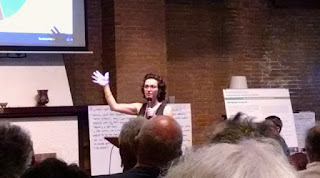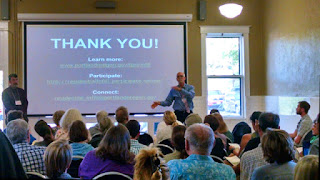 |
Neighbors pack Tabor Space on June 28 to hear a vision of the city
that came out of the Residential Infill Project. Overheard
outside afterward: "Honey, are you ready to move out of Portland yet?" |
Many have spoken up at the open houses held so far to review the Bureau of Planning's recommendations that came out of the becoming-infamous Residential Infill Project (RIP). This week brings two opportunities, from the neighborhood office in East Portland to the German American Society, Northeast 57th Avenue and Sandy Boulevard. Check the banner for more dates and details to make your concerns known.
Speaking of concerns, United Neighborhoods for Reform (UNR) developed a set of talking points to keep the conversation going, and in favor of viable, existing housing. Some highlighted excerpts, with background following:
The RIP Process
· The RIP Stakeholder Advisory Committee was supposed to be a balanced group representing varied interests. Instead, the RIP scope/process was hijacked by developers, “housing advocates” and moneyed interests who used it as a platform to create more opportunities to pad their profits by encouraging demolitions and building many more homes unaffordable to 90% of existing Portland residents.
· Essential analysis and modeling has not been done by our “green” city to predict the economic, neighborhood and significant environmental impacts of the proposal and whether any part of the BPS plan would produce the original desired results. The burdens and costs of this proposed development will fall on current residents.
· Adequate infrastructure of streets, sidewalks, sewers, public transportation and traffic management does not exist to support the increased density. The RIP process is seriously flawed by not including input, available to the public, from transportation, environmental services and other city staff responsible for infrastructure planning.
“Affordable” Housing
· There is no evidence that the proposed plan will result in “affordable” housing and reduce displacement. There is, however, strong recent evidence that new construction results in significantly increased housing unit prices. Building more units will not decrease the price of the units.
 |
City planner Sandra Wood makes some power points at
the RIP open house on June 28 in Southeast Portland. |
· Truly affordable housing for those with lower incomes requires ongoing governmental subsidies. This Bureau of Planning and Sustainability (BPS) plan is not a solution. To argue the BPS plan will solve Portland’s housing crisis is inaccurate.
· Stating that more construction will result in “affordable” housing is a smokescreen created by developers looking for more construction opportunities and profits.
Increased Density
· The City Council proposal, supported by BPS, to open up huge areas of the city to radically increased density (density that is greater than currently allowed in zone R2) without any modeling is irresponsible. Increasing density a quarter-mile from Centers, Corridors and frequent transit and Max stations includes most of the city and is not necessary.
 |
At the Kenton Firehouse on July 6, planning chief Joe Zehnder
takes a turn touting the current proposal making
the rounds citywide. Neighbors have debated its merits, intent,
and value through three open houses since mid-June. |
· The city’s Growth Scenarios Report states there is adequate vacant and undeveloped land to meet the city’s projected growth needs twice over until 2035 without increasing density in existing stable neighborhoods.
· If the city wants to increase density in single-family residential neighborhoods a zone change and proper public input/process is required.
· Indiscriminate infill density increases will greatly accelerate the demolition trend, resulting in the loss of many additional viable, relatively affordable houses.
Lot Divisions
· Lot divisions involving historic narrow lots should be allowed in R2.5 only.
· Allowing lot divisions throughout the city will stimulate many more demolitions of viable houses.
And finally:
UNR Supports
· The only portion of this proposal we can support is the plan for substantially reduced house size based on the size of the lot, using the tool of Floor Area Ratio (the total square feet of the building related to the total square feet of the lot). However, an improvement to this proposal would be: house height, size and setbacks to be determined by the local neighborhood context, in contrast to the one-size-fits-all neighborhoods concept proposed by this plan. One zoning code does not fit all the varied areas of the city.
Background
The RIP was initiated by Mayor Hales because of the following concerns of residents,
none of which are adequately addressed by the Bureau of Planning and Sustainability proposal resulting from this project:
o Demolitions of viable, relatively affordable houses.
o Construction of large, out of context, expensive replacement
houses.
o Lot divisions that result in demolitions and the replacement by
two or more out of scale houses.
o Threatened loss of cherished neighborhoods.
Protect Portland
·
Many of our neighborhoods are
vibrant, walkable, healthy places to live—the reason so many people want to
live in Portland. Why destroy these neighborhoods in the name of density and
developers’ profits?


